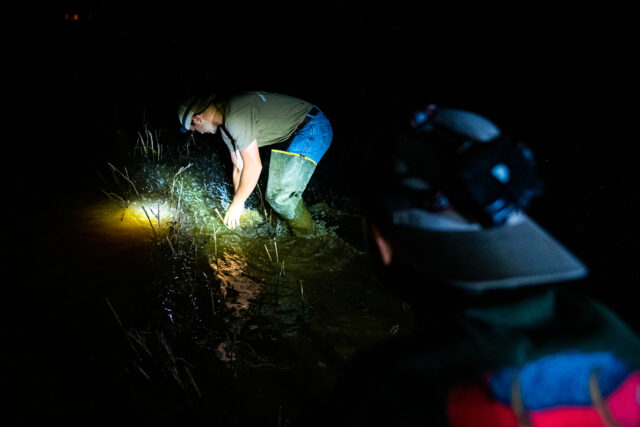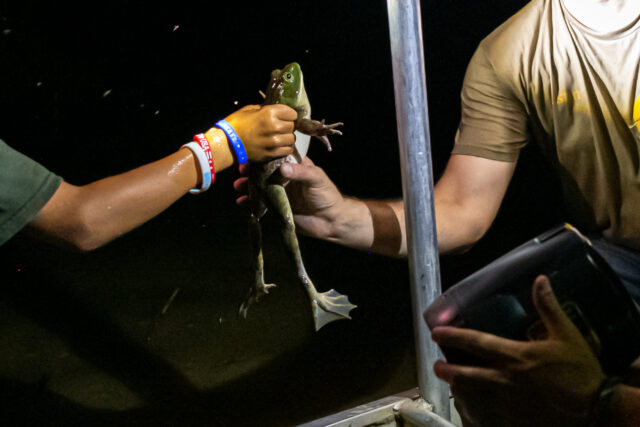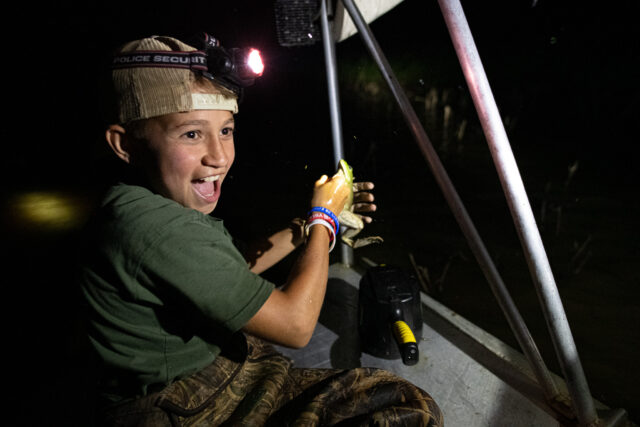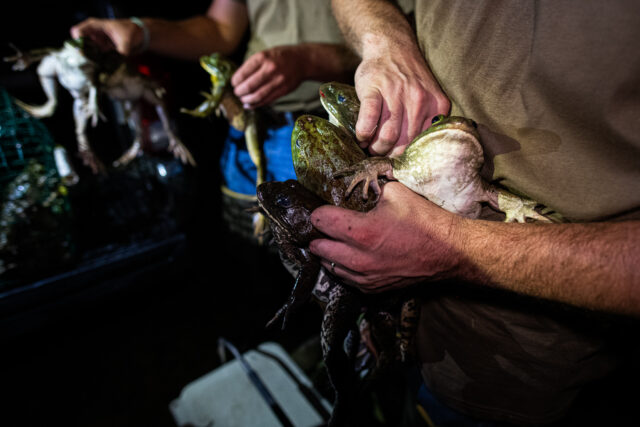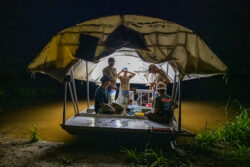Reach for the Back and Pray
Frogging in Jefferson Davis Parish
Published: August 30, 2021
Last Updated: March 22, 2023
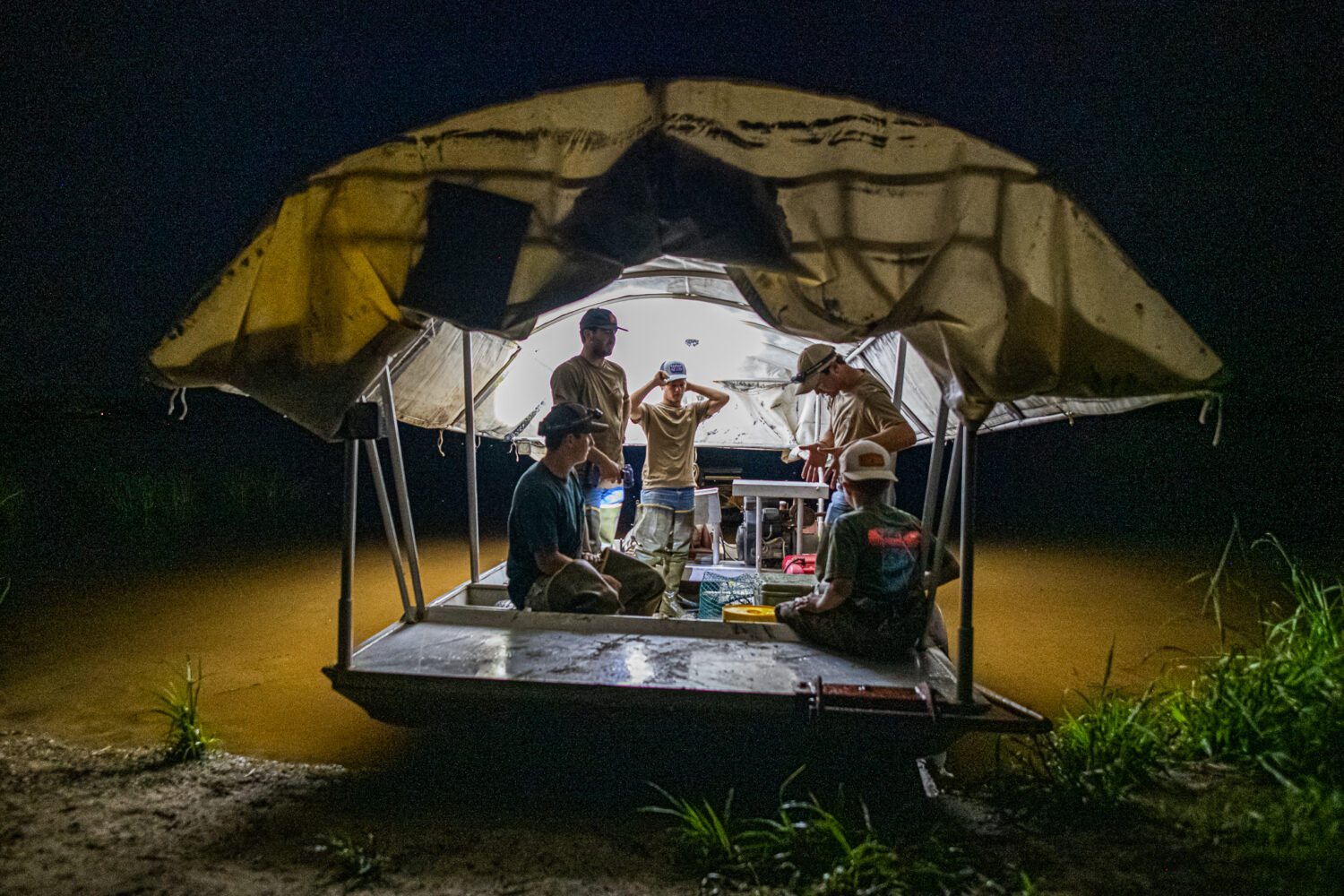
Story and Photos by Kevin Rabalais
J.D. Bolmarcich, Austin Bertrand, Jack Chaisson, Kane Hebert, and John Wesley Sonnier prepare to frog aboard a crawfish boat in Pine Island, Jefferson Davis Parish, Louisiana.
Bertrand chose the land. His family’s fields—more than a thousand acres in Jefferson Davis Parish—offer one story of a region that produces some of Louisiana’s archetypal crops. On one side of the road, crawfish boats rise over low levees before sliding into adjacent ponds. On the other, pumps flood fields with 3,500 gallons of water a minute in preparation for rice season. In this way, one landscape becomes another.
The facts of farming life—how many pounds of rice per barrel, how many sacks of crawfish an acre of pond can yield—flow readily from Bertrand, but for him, the land is more than a livelihood. He thrives on its pleasures—among them frogging, a tradition that his father passed onto him.
Frogs, much like crawfish and rice, also have their season—in Louisiana, every month except April and May (to avoid interfering with spawning). Ask Kane Hebert, a fifth-generation rice and crawfish farmer, why he frogs, and you can hear him smile. “My first memory of ever being in a crawfish pond is of catching a frog,” he said. Like Bertrand, Hebert grew up frogging with his father. When I joined them one night in early June, Bertrand and Hebert, along with Jack Chaisson, J.D. Bolmarcich, and John Wesley Sonnier, pulled on well-worn army green waders to continue the tradition.

Bertrand and Bolmarcich scan the crawfish pond for bullfrogs while Chaisson navigates the crawfish boat.
For them, frogging equals community and ceremony. In Louisiana, food orbits both. Donat Pecheu, a Frenchman who traveled to South Louisiana in the late nineteenth century, often gets credit for recognizing frog legs as a delicacy—in the 1880s, Pecheu started selling frogs to New Orleans restaurants. Today, personal chef Victoria Loomis of The Gatherin’ Girl maintains that culinary custom. “Frog has a mild flavor like a chicken breast,” she said, “but it doesn’t have the same heavy density. You can manipulate the flavor in a lot of ways. It’s great with any kind of citrus.” Besides that, Loomis admires something else about frogs: “I also like knowing that it’s locally sourced, knowing that I’m benefiting the ecosystem.”
The farther south you go, the bigger the frogs, or so believes Bolmarcich, who also frogs in Mississippi. “People who frog outside of Louisiana get to Ruston and say, ‘I’ve never seen a frog this big,’” he said. Hebert seconded that. They all agreed on something else: frogs taste better as you get deeper into the South. “They’re so good here because of the crawfish,” Bertrand said. “They’re addicted to the crawfish.”
There are multiple ways to catch frogs, including by hand, with a grabber, or with a pronged spear, or gig. Some who catch by hand maintain that gigging is cruel and damages the frog. Many gig, however, because it doesn’t require close proximity to the frog. Bertrand prefers frogging “par la main,” by hand. He keeps the frogs alive overnight by covering them with wet burlap and, abiding by law, throws back any bullfrog smaller than five inches from mouth to the posterior end of the body between the hind legs. At the beginning of June 2021, he caught the biggest frogs he had ever seen, some close to seven inches and weighing nearly five pounds.
Bertrand wants others to know the land and what it offers. “We started Frog Co. with the hopes to bring this great experience of catching big bullfrogs to people that don’t have this in their backyards,” he said. “We grew up doing this and feel that it is part of our culture. Our services start from a guided frogging trip to a complete package of a meal, live Cajun music, an overnight stay, and leaving with the cleaned frogs you harvest from the night before.”
John Wesley Sonnier, age twelve and already a frogging veteran, perched on the bow of the boat. He raised his flashlight in anticipation. Bugs shimmered like confetti. With headlamps on, Bertrand, Bolmarcich, Hebert, and Chaisson scanned the bank. Every few minutes, fingers pointed the way, and Sonnier leapt to his feet. Chaisson slowed the boat. With all lights targeting the frog, Sonnier slipped into the water. Few frogs escaped, and these five seemed to have just as much fun when they did.
“When you’re getting up close to that frog, and then when you finally hold it up in the boat—that’s when you know you really got something,” said Bertrand. Later, after the thrill of the hunt, comes the banquet. “I love them wrapped in bacon and barbecued or browned down with sausage and tomato for a sauce piquant,” he said.
To the young Sonnier, this late-night work is anything but. His pure joy serves as a testament to why this tradition endures. For anyone who wants to go frogging, he has this advice: “Reach for the back and pray, especially if it’s the biggest frog you ever caught.”
Kevin Rabalais, a writer and photographer from Avoyelles Parish, teaches in the Department of English at Loyola University New Orleans.
